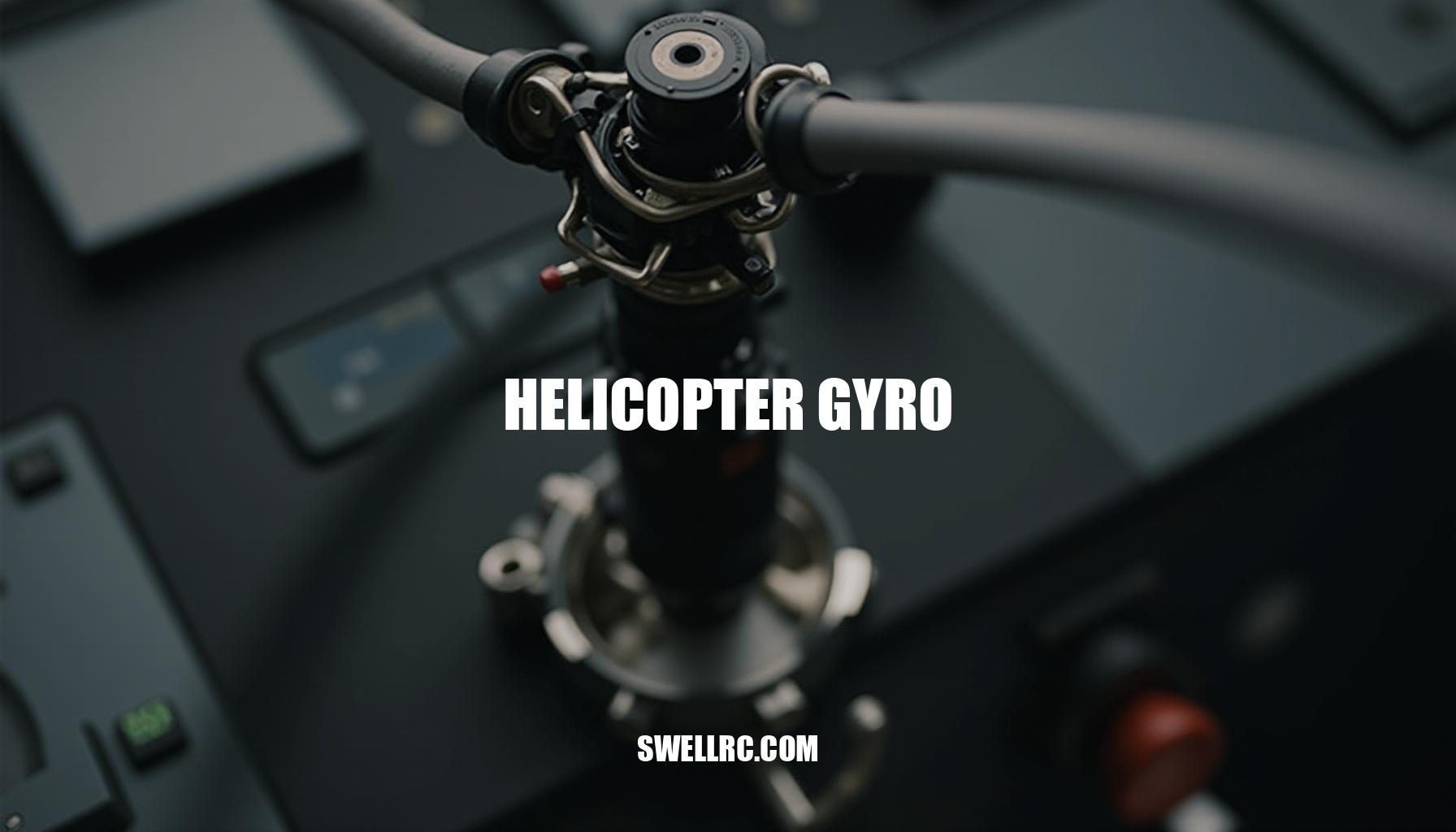The Ultimate Guide to Helicopter Gyros
There’s a moment every RC pilot remembers: the first flight where the helicopter feels locked-in, calm, and precise—even when the wind says otherwise. That magic comes from a helicopter gyro. In simple terms, a gyro is a tiny sensor and control assistant that constantly measures how the heli rotates and instantly corrects it, keeping your bird steady and responsive.
It’s the difference between chasing the tail and painting smooth lines in the sky. We’ve come a long way from mechanical flybar systems to micro gyro sensor technology, heading hold gyros, and fully integrated flybarless systems that do far more than just tame yaw. Even beginner-friendly models showcase the tech beautifully, like the Syma S107G RC helicopter with gyro: https://www.swellrc.com/syma-s107-s107g-rc-helicopter-with-gyro-red/.
The first time I toggled gain on a new setup and watched tail rotor control snap into perfect yaw correction, I knew I’d never go back—gyros turn nervous flights into pure, confident fun by enhancing the entire flight control system for unbeatable RC helicopter stabilization.
How Helicopter Gyros Work – The Science Behind Stability
Think of balancing a tray of water while walking: your hands make micro-adjustments to keep it level. This is essentially how gyro technology works in RC helicopters and planes. Inside the gyro, a MEMS sensor measures angular velocity—how fast the model rotates around one or more axes, commonly yaw, pitch, and roll.
The gyro acts as a sophisticated balance system, sending tail and rotor corrections to counter any unwanted motion, ensuring a stable and predictable flight envelope. This is crucial in helicopter flight dynamics, where the gyro provides heading hold to lock the heli’s heading until you command a change, combined with advanced digital filtering to reject vibrations.
Curious about how similar technology stabilizes wings? RC plane gyros use the same principles to enhance control and stability. Here’s a quick comparison table summarizing the typical gyro types and their applications:
| Type | What It Stabilizes | Performance | Typical Use |
|---|---|---|---|
| Single-axis gyro | Yaw only | Solid tail hold | Scale flying, older setups |
| 3-axis gyro | Yaw, pitch, roll | Strong stability and precision | Sport/3D practice |
| 6-axis gyro | 3-axis + accelerometers | Adds auto-level/rescue | Beginners, windy conditions |
A quick anecdote: I once lifted off with a fresh build that drifted in yaw. A fast re-calibration and proper gain setting transformed the flight—no tail wag, just clean, confident tracking. This real-world example highlights the essential role of MEMS sensors and gyro systems in maintaining precise control and smooth flight performance.
Types of Helicopter Gyros and Their Functions
When choosing the right gyro system for your RC helicopter, understanding the differences between a single-axis gyro, three-axis gyro, 6-axis gyro, and a flybarless system is crucial for achieving optimal performance stability. Single-axis gyros focus solely on yaw stabilization, making them affordable and perfect for simple scale flights where reliable heading hold on the tail is desired. In contrast, a three-axis gyro offers combined stabilization capability for yaw, pitch, and roll, striking a modern balance that reduces pilot workload and provides sharper response suitable for a variety of skill levels.
For beginners or flying in tricky conditions, a 6-axis gyro incorporates accelerometers that enable auto-leveling and rescue features, improving control in gusty winds.
Meanwhile, an advanced flybarless system replaces the mechanical flybar entirely, integrating either 3- or 6-axis controllers that reduce aerodynamic drag and deliver highly precise control and tunability—the preferred choice for expert pilots.
| Type | Stabilization Capability | Cost | Setup Complexity |
|---|---|---|---|
| Single-axis gyro | Yaw only | Low | Low |
| Three-axis gyro | Yaw, pitch, roll | Medium | Medium |
| 6-axis gyro | Yaw, pitch, roll + auto-level/rescue | Medium-High | Medium-High |
| Flybarless system | Full control integration (3- or 6-axis) | Medium-High | Medium-High |
From personal experience, after hours spent tuning various setups, the best balance between simplicity and control comes from a quality 3-axis flybarless unit—intuitive to configure yet providing absolutely locked-in stability and performance.
Real-World Examples — Gyros in Action Across RC Helicopters
Different airframes showcase gyro magic in distinct ways, significantly enhancing stability in wind and delivering smooth control for RC helicopter enthusiasts. For instance, the Boeing CH-47 Chinook RC helicopter utilizes a specialized balance system to keep its unique tandem-rotor layout harmonized in yaw and pitch, demonstrating innovative gyro implementation. Meanwhile, the Yuxiang F09 Black Hawk benefits greatly from a heading hold gyro, resulting in a scale-stable tail and incredibly smooth transitions during flight.
Among manufacturers, SAB Goblin platforms stand out with their renowned flybarless precision, offering aggressive yet predictable 3D performance. Compact models like the RC helicopter C186 leverage advanced 6-axis balance systems to maintain user-friendliness for newcomers, greatly reducing crash risk through enhanced stability.
If you’re eager to explore a wider variety of builds and tuning notes, visiting curated RC helicopter websites and communities offers invaluable insights into how different gyros and balance systems are implemented across models.
| RC Helicopter Model | Gyro Type / Balance System | Key Benefit |
|---|---|---|
| Boeing CH-47 Chinook | Stabilization for tandem-rotor coordination | Harmonized yaw and pitch stability |
| Yuxiang F09 Black Hawk | Heading hold gyro | Scale-stable tail and smooth transitions |
| SAB Goblin Platforms | Flybarless precision gyro | Aggressive yet predictable 3D flight |
| RC Helicopter C186 | 6-axis balance system | User-friendly; ideal for beginners |
From personal experience, the first time I flew a well-tuned 6-axis controller in gusty air, the helicopter held such a steady attitude that I focused more on perfecting flight lines rather than battling the wind—a truly night-and-day difference in confidence and control.
Gyro Setup, Calibration, and Troubleshooting
Setting up your helicopter gyro correctly is crucial for achieving smooth and stable flight performance. Follow this comprehensive gyro setup guide to ensure optimal calibration and sensitivity adjustment. First, mount the gyro on a rigid, level surface using proper foam or gel to ensure effective vibration isolation.
Confirm the gyro’s orientation in the software, making sure the arrow points forward or right as specified by the manufacturer. Update the firmware and select the correct helicopter type, distinguishing between flybarless and scale models. Wire the gyro properly to the receiver and set the tail servo type and frequency according to your setup.
Mechanically center the tail and swashplate, ensuring there is no binding that could affect control response.
Initial gain values should be set conservatively to avoid aggressive responses. It’s important to verify the compensation directions by manually moving the helicopter and verifying that the gyro corrects in the appropriate direction. Perform the level calibration on a truly flat and stable surface for accuracy.
Once these steps are complete, test hover and fine-tune parameters such as gain, agility, and expo to suit your flying style.
Integration matters when pairing your gyro with a suitable helicopter remote control. Features like rate and heading hold switches or rescue assignment can facilitate easy in-flight tuning. For indoor flight enthusiasts, incorporating IR control systems may enhance your setup’s flexibility and responsiveness.
In case of any issues, here are some quick troubleshooting tips:
- Helicopter spins uncontrollably: reverse the gyro compensation on yaw axis.
- Tail wag: reduce tail gain or check for linkage friction.
- Persistent drift: re-level calibration and inspect vibration mounting tape.
- Sudden twitching: verify power supply, BEC, and servo health.
- Auto-level tilts: recalibrate accelerometers on a dead-flat surface.
- Elevator/aileron oscillation: lower main gains or add vibration damping materials.
Pro tip: After calibration, gently power-cycle the helicopter and allow the gyro to fully initialize on a stable surface before spool-up to ensure the best performance and reliability.
The Future of Gyroscopic Flight Technology
The future of gyros is rapidly evolving with the integration of advanced MEMS sensors that significantly enhance noise performance and temperature stability. These compact sensors allow gyro units to become smarter and smaller, ushering in a new era of precise control for RC enthusiasts and aviators alike. Coupled with AI-assisted stabilization, modern gyros can learn your airframe’s unique vibration profile and recommend optimal gains for a smoother flight experience.
Flybarless systems now commonly incorporate a variety of advanced features such as auto-level features for effortless orientation, rescue modes that enable quick recovery from unintended attitudes, governor control for consistent rotor speeds, and extensive logging capabilities for post-flight analysis. Furthermore, some units employ predictive filtering to accurately distinguish between genuine motion and sensor noise, improving overall stability and control.
In full-scale aviation, technologies like Advanced Attitude and Heading Reference Systems (AHRS) and Inertial Navigation Systems (INS) maintain aircraft stability and situational awareness. These sophisticated systems have inspired improvements in RC gyro technology, resulting in better state estimation and enhanced fault tolerance.
The overlap between full-scale and RC gyro technologies is truly exciting, marked by:
- Smarter sensing capabilities
- Cleaner and more responsive control loops
- Reliable balance systems that require less pilot intervention
Each new generation of helicopter gyros unlocks fresh creativity. Pilots spend less time firefighting issues and more time flying intentional lines, experimenting with innovative maneuvers, and refining their style. The horizon looks bright with lighter hardware, richer software suites, and pilots able to fully embrace the art of controlled motion.
Conclusion — What Makes a Helicopter Gyro Indispensable
From the first hover with a heading hold tail to the precision of a tuned flybarless system, a helicopter gyro changes everything. You’ve seen how they sense motion, command smart corrections, and deliver stability that builds confidence—whether you’re practicing scale circuits or pushing 3D. Choosing the right gyro, installing it carefully, and calibrating with intention turns a nervous maiden into a controlled, enjoyable flight session.
For those eager to deepen their RC helicopter knowledge, consider these essential areas of focus:
- Gyro Models: Understand the capabilities and limitations of popular helicopter gyros.
- Setup and Calibration: Learn precise techniques to optimize gyro settings for peak performance.
- Community Insights: Leverage forums and guides to expand your flight control mastery.
Remember, mastery comes from curiosity and iteration. Test, tune, and trust your gyro—because a stable helicopter frees you to fly with purpose and joy. With proper setup and calibration, and a keen understanding of flybarless precision, your flights will demonstrate unparalleled stability and enhance your confidence in every maneuver.
Frequently Asked Questions
- What does a gyro do in an RC helicopter?
A helicopter gyro senses unwanted rotation (yaw, pitch, roll) and automatically commands corrective inputs to the tail and main rotor, keeping the model stable, responsive, and easier to control. - How does a helicopter gyro stabilize flight?
It uses MEMS sensors to measure angular velocity, applies heading hold or rate corrections, and drives the servos to counteract drift and gusts—resulting in steady hover, clean tracking, and predictable maneuvers. - What are the types of gyros used in RC helicopters?
Common types are single-axis (tail/yaw only), 3-axis (yaw, pitch, roll), 6-axis (adds accelerometers for auto-level/rescue), and fully integrated flybarless systems that handle all stabilization and tuning. - Do real helicopters use gyros like RC models do?
Yes—full-scale aircraft use advanced gyroscopic sensors within AHRS/INS to maintain attitude and heading, similar in principle to RC gyros but with higher redundancy and certification standards. - How do you set up and calibrate a helicopter gyro?
Mount it on a vibration-damped, correctly oriented surface; wire it properly; center mechanics; set gains conservatively; verify compensation directions; and perform level calibration on a flat surface before test flights. - Are 6-axis gyros better than 3-axis gyros for beginners?
Often yes, because 6-axis units add auto-level and rescue features that reduce workload and help in wind. As skills grow, many pilots prefer 3-axis flybarless with more direct control.



